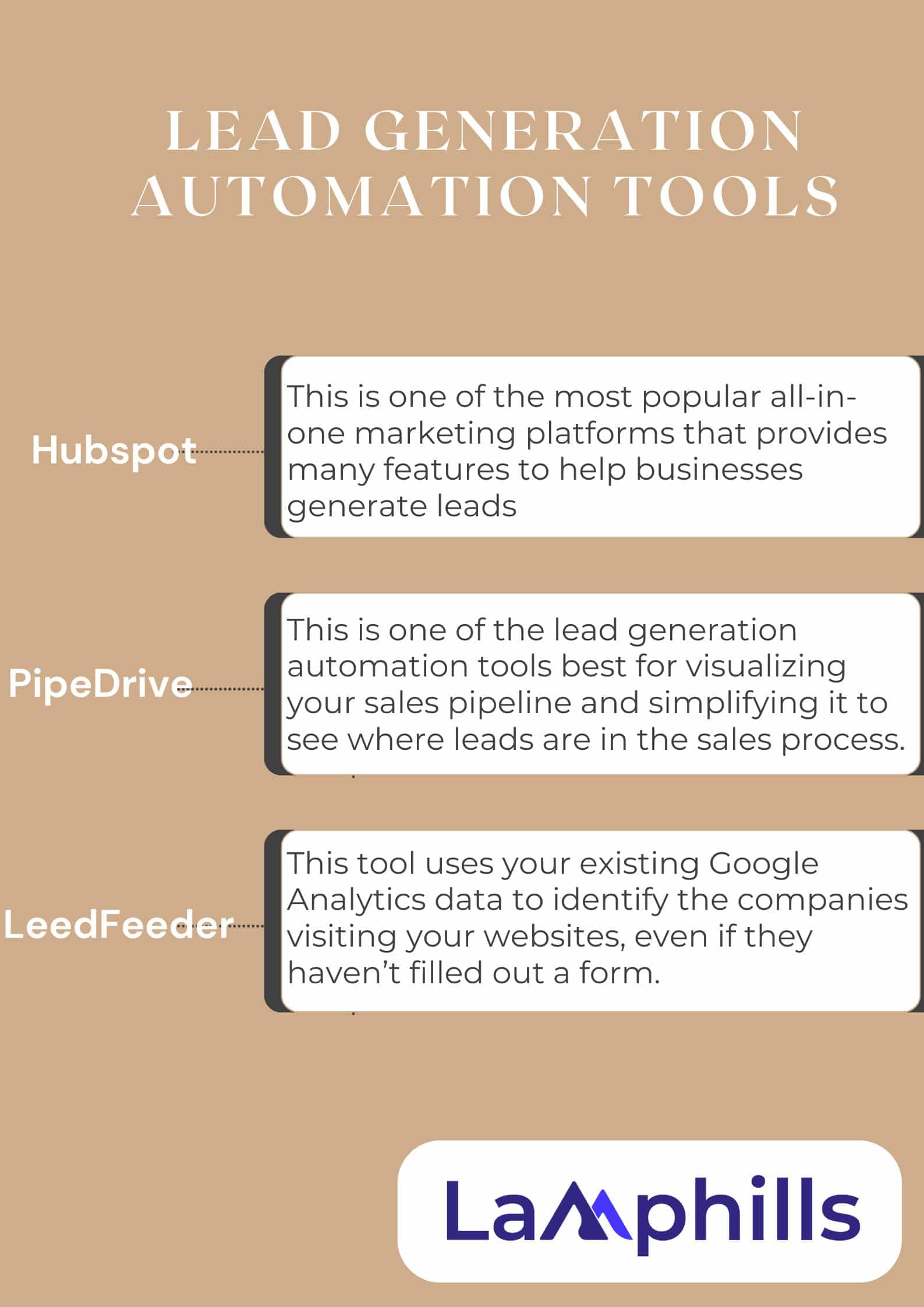Lead generation is an important part of keeping your business competitive and thriving. It is an important requirement for running a successful business online, but it can be one of the most time-consuming and frustrating tasks. Now, there is a solution called lead generation automation. It can enhance your productivity, save time, and get you quality leads that will contribute to higher income. Furthermore, I will walk you through the lead generation automation tools that will help you get more quality leads.
Key points
- Lead Generation Automation can enhance productivity, save time, and generate quality leads that contribute to higher income. It also helps speed up the process of discovering new customers.
- Inbound lead generation automation attracts leads through content, chatbots, and pop-ups, while outbound lead generation automation reaches out directly via email marketing, prospecting tools, and social media.
- To implement lead generation automation, businesses should identify their target audience, segment contact data, choose and integrate the right tools, create and share content, nurture leads, and convert leads into customers.
- Top tools for lead generation automation include HubSpot, PipeDrive, and LeadFeeder.
- The benefits of lead generation automation include improved efficiency and lead quality
Lead Generation Automation
Lead Generation Automation means using software and tools to automate or speed up discovering new customers. Automating tasks like lead capture, scoring, and nurturing your business can generate a consistent flow of qualified leads with simple manual effort. For instance, when I was working on content for a B2B software company, we used Hubspot for our lead generation processes. I assisted in creating content customized to various stages of the buyer’s journey.
While using the Hubspot tool, it did a lot, like capturing leads from blog posts, white papers, and webinars and scoring some leads based on how they interacted with the content. In addition, we set up automated email campaigns that sent personalized content to these leads and guided them through the sales process. After everything, lead automation brought a steady flow of qualified leads, allowing the marketing team to focus on creating content. Also, the lead management process ran smoothly and was easy to do with manual effort. Here is a video below.
Read Also: Utilizing Marketing Automation for Effective Lead Generation
Types of Lead Generation Automation
Several automation tools are available on the market. But first, I will walk you through the different types of sales and marketing lead generation automation to help you discover the right tool. These two types of automation Lead generation work better when you collaborate.
#1. Inbound Lead Generation Automation
This is a marketing tactic you use to attract leads to your business. For example, a marketing team can create relevant content with high-quality leads for your business. The goal of the content is to make sure a lead takes specific actions that will lead to sales. Inbound lead-generating automation concentrates on assisting rather than selling.
In addition, this marketing strategy involves simplifying tasks using automation tools. For example, you can apply the following tools to automate your inbound tasks.
- Chatbot: it provides answers to questions
- Pop-ups & form: offers personalized content, lead magnets, or surveys on the website
When I worked in a small e-commerce startup, we had a significant challenge with our lead generation process. It was time-consuming, and we struggled to keep up with the inflow of potential customers. During a particularly busy week, we explored automation tools to simplify our efforts.
We integrated a chatbot to answer common questions and guide customers to relevant content. Next, we implemented pop-up forms that offer discount codes in exchange for email addresses when visitors spend over a minute on the product page. This strategy not only grew our email list but also provided tailored offers.
#2. Outbound Lead Generation Automation
Unlike inbound lead generation, outbound lead generation automation involves finding and reaching out to your ideal leads directly rather than waiting for them to come to you. In this instance, you can automate outbound lead generation using the tools listed below.
- Email Marketing and Outreach Tools: These are used for outbound marketing and sales to automate sending emails, newsletters, or themed email sequences.
- Prospecting Tools: These are used for marketing and sales to find outbound leads and contact information.
- Social Media: This is used for sales to automate outreach on social media.
- Advertising tools: Marketers used this tool to automate buying in the digital advertising space.
I worked at TechWad, a B2B software company, a few years ago. We had challenges growing our outbound lead gen. The sales team struggled to keep up with the number of prospects because manual outbound lead gen was time-consuming. So, we decided to automate it to improve efficiency. We utilized email marketing tools to create personalized sequences, saving time and increasing response rates.
Read Also: A Comprehensive Guide to AI Marketing Automation and Best Tools in 2024
How to Implement Lead Generation Automation
Despite all these, changing to new technology can be difficult. I recall some time ago when our company considered automation in our lead generation system for the first time. Its potential was thrilling and intriguing, with increased efficiency and a consistent cash stream from excellent leads.
However, the company was filled with questions, uncertainties, and challenges in its journey to implement Lead generation automation. If you are feeling the same mix of excitement and worry. You are in the right place. I have found a systematic way that will make transitioning more manageable for you.
The following are some comprehensive steps that will help you implement lead-generation automation in your organization
#1. Identify Your Target Audience
Before anything else, you must be clear about the leads you want to attract. You must identify and describe your target audience in detail. When identifying them, you might also want to use demographic data, such as location, age, and gender. To make it easier, I suggest you consider what your audience will be interested in and why they will purchase from your company.
#2. Gather and Segment Contact Data for Your Leads
The next step is to ensure that your lead generation automation tools are effective. Once you have collected the correct contact data, put it to good use by dividing the data into different segments. For example, demographic segments or segments based on a particular activity, such as having a sales-qualified group of leads. After dividing the data, you can target direct marketing efforts to specific segments.
#3. Choose the Right Lead Generation Automation Tools.
You must choose the appropriate automation tool that suits your organization’s needs. The appropriate tool will streamline your procedures, save time, and improve your bottom line. But how can you determine which tool is best for you? Let me share an experience that will shed some light.
Some time ago, when I was working at a law firm as a legal assistant, we were overwhelmed with client inquiries and potential leads. We were sure we needed an automation tool to manage the inflow. We didn’t know where to start but later tried a few popular tools to see the best. After trying out a few well-known tools like CRM, we switched to a simpler, user-friendly one offering customer support.
Additionally, I suggest that you assess your needs before exploring options. Know whether a simple lead capture form, email marketing, or comprehensive CRM is best for you.
#4. Integrate Your Chosen Platform
Once you’ve chosen your lead generation tools, you must add them to your workflow. For example, if you are using a CRM, you must be able to integrate your new automation tool with your existing tech stack. This will save you time and ensure your leads are quickly included in your overall sales process.
#5. Start Generating and Sharing Content
With the tools in place, you’re ready to start creating and sharing content. For example, in the case of an automated ad campaign, you will develop the ad copy and design before letting the automation tool run the campaign across many channels you need; all it requires is just a few clicks. It’s not only about ad campaigns, but it depends on your organization’s priorities and your target audience.
#6. Nurture Your Leads
It’s not enough to identify high-quality leads; you must nurture and retain them immediately after you’ve reached out. Nurturing your leads involves staying in regular contact with them and only providing them with relevant information. I understand you’re wondering if this can be automated; of course, it can. Lead-generation tools like AI chatbots can nurture leads without diverting attention and resources from other essential duties.
Below is a Lead nurturing sequence template that can be customized based on your specific audience and goals. This ensures that each email provides value and moves the lead closer to conversion.
Lead Nurturing Sequence Template
#7. Convert Leads into Paying Customers
This is the last and most important stage. Ensure that you convert your leads into paying customers! This means having successful landing pages for leads when they are directed to your well. They must also have support throughout the buying process, which reduces the chance of cart abandonment.
Read Also: What Is SaaS Marketing Automation? 8 Best Tools and Strategies for Your Brand
Lead Generation Automation Tools
In 2019, I remember drowning in spreadsheets, trying hard to make sense of a messy mix of data to find high-quality leads. One day, our boss introduced us to lead generation automation tools in a seminar he hosted for staff members. After that, everything changed drastically; almost everyone in the office applied these tools, and we all experienced dramatic improvements in lead quality and a rush of new clients. Fast forward to 2024, the world has evolved more with more powerful lead automation tools.
Here are some lead generation automation tools that modernized my approach, and they can do the same for your business.

#1. HubSpot
This is one of the most popular all-in-one marketing platforms that provides many features to help businesses generate leads, such as:
- CRM Integration: this feature is used to organize leads in one place, and it is easily managed
- Email Marketing: it creates and sends out target email campaigns.
- Marketing Automation: the feature is to automate repetitive tasks to save time
- Analytics: it uses intelligent data to monitor and evaluate your performance.
- Lead Capture: this tool captures your leads with customizable forms and pop-ups
- Social Media Management: it publishes your content and manages your social media profile
HubSpot has many price plans for diverse requirements.
- Free Plan: email marketing and reporting features are free
- Starter: starting at$45/monthly, including essential features for small businesses
- Professional: offers advanced tools for growing business with the starting price of $800/month
- Enterprise: starting at $3200/month, has premium features for large business
#2. PipeDrive
This is one of the lead generation automation tools best for visualizing your sales pipeline and simplifying it to see where leads are in the sales process. It has other stand features, they are:
- Email integration: this feature syncs emails with leads directly within the platform for smooth communication.
- Activity Tracking: Its function is to monitor interactions with leads to stay on top of your sales process.
- Pipe Drive has 5 pricing options: essential, advanced, power, professional, and expertise. Its sales lead software has a layered pricing plan built annually per user.
#3. LeedFeeder
This tool uses your existing Google Analytics data to identify the companies visiting your websites, even if they haven’t filled out a form. It has the following standout features.
- Website visitors Tracking: it sees the company that visits your website.
- Lead identification: it provides the contact information for key decision-makers
- Behavioural Data: This feature understands visitors’ interests and intentions.
- Email Alerts: This feature gives out notifications whenever there are new leads and returning visitors.
- CRM Integration: it connects with popular sales tools.
- Customizable Filters: This feature focuses on high-priority leads
LeedFeeder is a free plan with some limited features and a paid plan billed annually. The free plan shows data from the seven days for up to 100 companies. The monthly payment plan is based on the number of companies you identify, starting at $99/month.
Conclusion
You must adopt lead generation automation to maintain a competitive edge, ensuring your business flourishes. You can get a steady flow of high-quality leads with little effort by automating tasks such as lead capture, scoring, and nurturing. My experience with many industries has demonstrated the significant benefit of tools like Hubspot, Pipedrive, and Leadfeeder in enhancing productivity and revenue.
When you carry out these strategies to simplify your process, it allows you to focus on creating valuable content and fosters strong customer relationships. Are you ready to elevate your business with lead generation automation? Let’s explore the best tools and practices.
What Is Lead Generation Tools?
Lead generation tools are software or web-based services that help organizations reach more prospects and convert them into customers. These tools are commonly used with other marketing methods, including email campaigns, website optimization, and social media management.
How to Create Lead Generation?
Lead generation brings prospects to your business and cultivates their interest, ultimately turning them into customers. Job postings, blog posts, coupons, live events, and online content can generate leads.
How Does Lead Generation Work?
Lead generation increases consumer interest in a product or service to convert it into a sale. In Internet marketing, this often involves gathering a visitor’s contact information (known as a “lead”) through
References
Related Articles
- 13+ Must-Have AI Automation Tools in 2024: A Complete Guide
- How to Implement Marketing Automation: An Easy Step-by-Step Guide (+ Templates)
- Top B2B Marketing Automation Strategies to Boost Your Business in 2024
- What Is Lead Generation Data: Purpose, Analysis, Tools and Best Strategy
- Getting Started with Content Automation: A Beginner’s Guide





